Objects of The Fellowship of the Ring
The Rings of Power
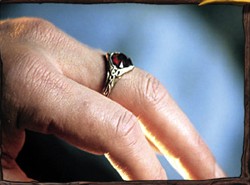

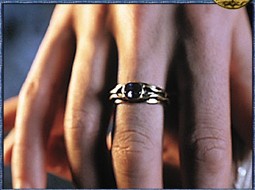
Before the events of The Lord of the Rings, Sauron forged the Rings of Power for the leaders of Middle-Earth: three for the rulers of the Elves, seven for the Dwarf-lords, and nine for the kings of Men. The nine rings given to the mortal race of Men were corrupted and tainted with evil, their bearers falling into shadow and becoming the Ringwraiths--slaves to Sauron's will. But the seven rings of the Dwarves were kept hidden and untouched, and the three crafted for the Elves were able to resist Sauron's evil power. From left to right:
Narya, the Ring of Fire,
was fashioned out of gold and set with a ruby. It was given into the keeping of Gandalf the Grey, who wore it until his passing over the Sea.
Nenya, the Ring of Water, was wrought of silver and adorned with a stone of adamant. It was owned by the Lady Galadriel until she, too, left Middle-Earth for the Undying Lands of Valinor.
Vilya, the Ring of Air, was shaped out of gold and set with a sapphire. The legendary Elvenking Gil-galad possessed it until the battle of the Last Alliance, where he entrusted it to the care of his herald Elrond Peredhil and passed into the darkness of Mordor.
The One Ring

The One Ring, the Ring to rule all other Rings of Power, was forged by Sauron in the fires of Mount Doom. It is an instrument of great evil, and has the power to corrupt all those who desire it. The Ring destroyed the might of Isildur through his pride and greed, and poisoned the mind of Gollum for five hundred years. Though it brought prolonged youth and long life to Bilbo, it wore away at his spirit until he could find no rest and set off to end his days far from home. Frodo is able to resist the temptation of the Ring, but it is a burden that weighs heavily upon him, and he will never fully recover from its influence.
The shards of Narsil

Narsil was the blade of Isildur, son of Elendil, during the battle of the Last Alliance--the sword that severed the Ring from Sauron's hand, ending the siege in victory. The blade itself was shattered at the hilt; the shards were transported to Rivendell and kept there in great honour, until the time when the sword was reforged as Anduril and carried by the heir of Isildur--Aragorn, son of Arathorn.
Sting

A Elvish magical blade, which will glow a bright blue when Orcs approach. Bilbo, who retrieved it from the goblins in The Hobbit, gives it to Frodo upon the Fellowship's departure from Rivendell.
Glamdring

Also called the Foe-Hammer, Glamdring is Gandalf's sword and shines a brilliant white if Orcs draw near. The wizard wields his enchanted blade only rarely, preferring to use his staff and considerable magical powers.
The wizards' staves

Every wizard on Middle-Earth carries a staff, carved out of wood and set with a crystal. The staff concentrates a wizard's magical powers and is his main weapon in a battle. Each staff reflects something of its bearer's personality: Gandalf's staff (shown on the right) is fashioned of gnarled, grey, weathered wood; Saruman's staff is smooth and black, with sharp, cruel edges.
The palantÝri

A palantÝr (Elvish for "far seeing") is an enchanted orb; in its depths, one may see visions of distant lands and peoples. The palantÝri are known as the Lost Seeing-Stones because of Sauron's influence on their powers; many of them are in the Dark Lord's keeping, yet one remains within the tower of Isengard under Saruman's control.
Mithril coat
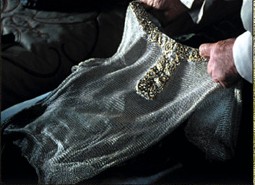
A dazzling array of silver-steel, light as a feather but hard as dragon's scales, mithril is wrought by the Dwarves and worn by the Elves in their armor. Bilbo picks up a mithril coat of mail from Smaug's hoard in The Hobbit, and gives it to his young ward and nephew as Frodo prepares to leave Rivendell. The mithril coat proves invaluable to Frodo in the mines of Moria; nearly killed by a spear wielded by a cave-troll, the blow is deflected by the coat of mail he wears under his shirt.
The light of Eńrendil

Before leaving Lothlˇrien, the Lady Galadriel gives Frodo a special gift: the pure, radiant light of Eńrendil, the star of the Elves, held within a crystal phial wrought by Galadriel herself. The light of Eńrendil will play an important role in Frodo's journey to come.
The horn of Boromir
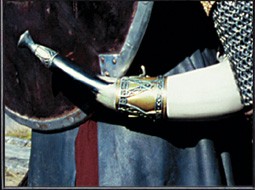
The horn worn by the warrior of Gondor is traditionally sounded in battle to summon the armies of the West. Boromir winds it as a desperate cry for help in his battle to defend Merry and Pippin at the Emyn Muil. The others--Aragorn, Legolas, and Gimli--hear its call and race to save him, but it is too late; the horn is sundered in half and Boromir is slain by the Ur˙k-hai.
Athelas
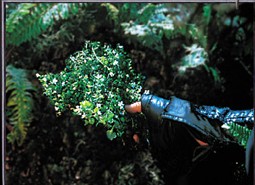
Also known as kingsfoil, athelas is a flowering plant growing in the wild. It has strong curative powers and is used often by Aragorn to heal others; the Ranger is able to ward off the infection in Frodo's deadly wound at Weathertop with an infusion of athelas.
Back












